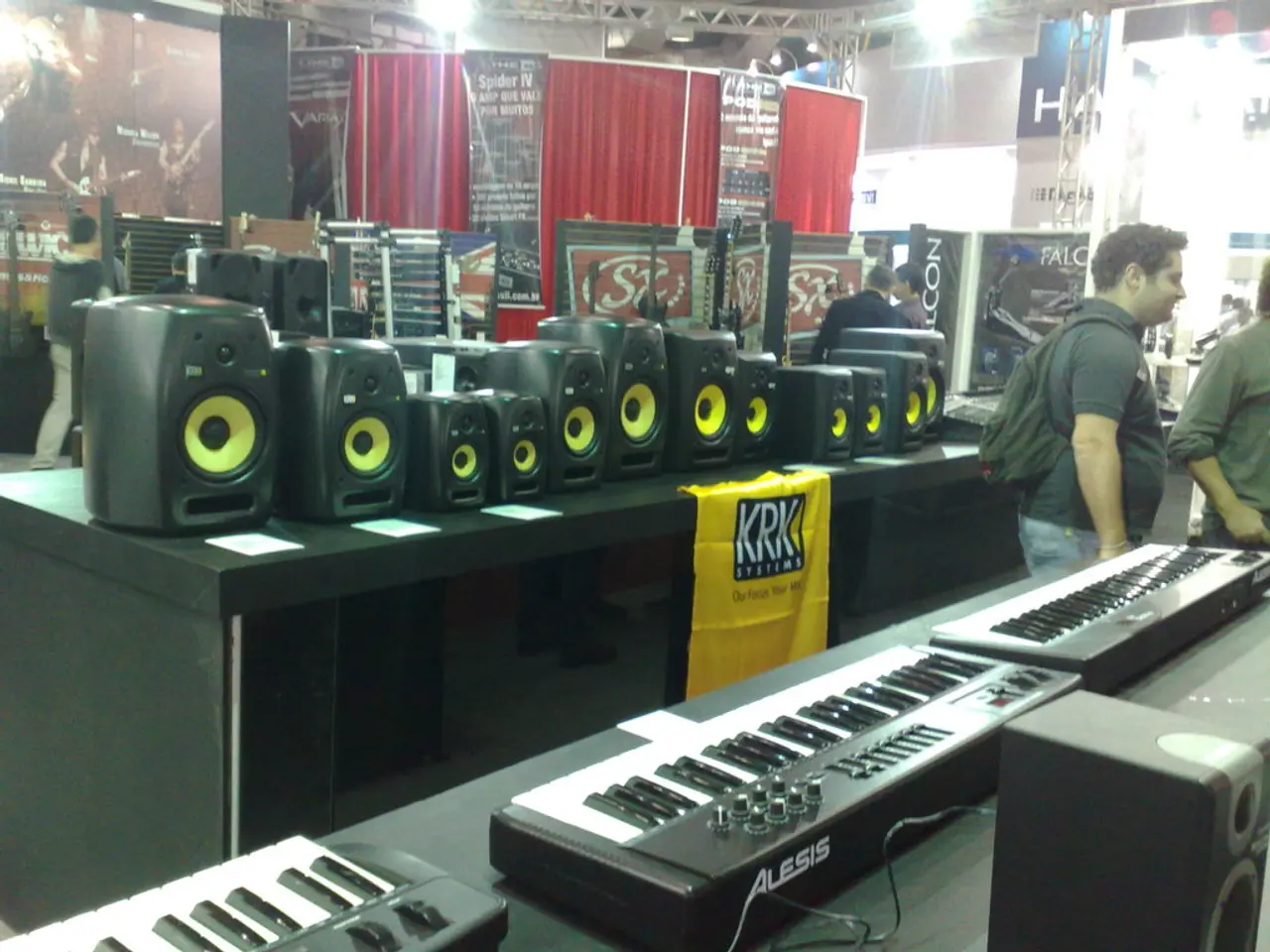Techniques for Recording Music Bands: Tips for Outstanding Sound Quality
Recording music from the comfort of your own home has never been easier, thanks to modern technology and a wealth of resources available to musicians. In this article, we'll explore some key strategies for creating a spacious soundstage, optimising your recording environment, and mastering your tracks for a professional finish.
Spreading Instruments Across the Stereo Field
Panning is a crucial technique for creating a spacious soundstage. By strategically placing each element of your recorded tracks, you can achieve a balanced and immersive mix.
Simplifying Music Distribution
Services like DistroKid and CD Baby make it a breeze to distribute your music across multiple platforms simultaneously, ensuring your tracks reach a wider audience.
Addressing Feedback Problems
Feedback can be a frustrating issue for any musician. To combat this, consider positioning microphones away from speakers, adjusting equalizer settings, and using a feedback suppressor.
Reducing Audio Interference
Interference can spoil even the best recordings. Check all cables for damage, use shielded cables, keep devices like smartphones away from audio equipment, and consider using a power conditioner to minimise interference.
Acoustic Treatment for Home Recording Studios
To improve the acoustic quality of your home studio, focus on reducing unwanted reflections and controlling sound behaviour inside the room. Here are some techniques you can employ:
- Use Bass Traps to control low-frequency sound waves that tend to build up in corners.
- Install Acoustic Panels on walls at key reflection points, such as between speakers and the listener, side walls, and the ceiling, to absorb mid and high frequencies and reduce echoes.
- Add Diffusers to scatter sound reflections and prevent harsh sound build-up or dead spots while maintaining a natural sound environment.
- Pay special attention to the ceiling, which often reflects sound vertically, by hanging acoustic baffles or clouds to reduce overhead echoes and improve clarity.
- Identify and treat "mirror points" for optimal panel placement, typically at ear level.
- Combine absorption and diffusion materials strategically to create a balanced acoustic environment with minimal coloration and echo.
By implementing these techniques, you can make your room sound more accurate for recording and mixing, minimising muddiness, echoes, and reverb, and enhancing clarity and precision.
Balancing Tracks in a Digital Audio Workstation (DAW)
Each element of your recorded tracks needs to be balanced for clarity and depth using a digital audio workstation (DAW). Communication is essential when creating headphone mixes, as it allows for collaboration with band members to adjust mixes to their preferences.
Editing Recordings
Editing helps to tighten and polish recordings by trimming unnecessary noise and silences, correcting timing issues, and using pitch correction for vocals. However, be mindful not to overdo it, as excessive editing can result in an unnatural sound.
Using Reverb and Delay
Reverb and delay should be used sparingly to give tracks a sense of space without muddying the mix. A little goes a long way, so experiment with different settings to find the perfect balance.
Tailoring Headphone Mixes
Tailoring headphone mixes is essential for musicians to hear an accurate representation of the track while recording. Each musician's instruments and vocals should be emphasised, striking a balance between all elements, and adding click tracks if needed.
Mastering Your Tracks
Mastering is the final step to transform a recording into a cohesive and polished piece. It improves sound quality through balancing sonic elements, tightening frequency balance, and adding sonic enhancements.
Recording Live Sound
Capturing the essence of a band's live sound on a recording emphasises the band's performance energy, natural dynamics, and uses minimal processing to maintain an authentic sound.
Multi-track Recording
Multi-track recording is effective for giving each instrument its channel, allowing for detailed post-production edits.
Managing Recording Errors
Ensure your recording software is up to date, monitor CPU usage, regularly clean up files, and back up recordings to minimise errors.
Essential Equipment for Recording a Band in a Studio Setting
When recording a band in a studio setting, essential equipment includes a mixing console, audio interface, quality microphones, headphones, a digital audio workstation (DAW), and acoustic treatment.
Ensuring Your Music Stands Out
Mastering helps music sound its best on various listening devices, ensuring it stands out in playback and leaving a lasting impression on the listener.
[1] Acoustic Treatment Techniques for Home Recording Studios [2] How to Set Up a Home Recording Studio [3] DIY Acoustic Treatment for Your Home Studio [4] Choosing the Right Acoustic Panels for Your Home Studio [5] Acoustic Foam Panels: Pros, Cons, and Alternatives
- Panning each element of recorded tracks can help create a spacious soundstage for a balanced and immersive mix.
- Services like DistroKid and CD Baby simplify music distribution, allowing musicians to reach a wider audience.
- To combat feedback in recordings, consider positioning microphones away from speakers, adjusting equalizer settings, and using a feedback suppressor.
- Reducing audio interference is crucial for high-quality recordings. Check all cables for damage, use shielded cables, keep devices away from audio equipment, and consider using a power conditioner.
- Acoustic treatment is vital for enhancing the acoustic quality of a home recording studio. Techniques like using Bass Traps, Acoustic Panels, Diffusers, and Acoustic baffles can control sound reflections and improve the room's clarity and precision.
- Balancing tracks using a digital audio workstation (DAW) is essential for achieving clarity and depth, while communication is essential when creating headphone mixes.
- Editing recordings helps tighten and polish tracks by trimming unnecessary noise, correcting timing issues, and using pitch correction for vocals, but excessive editing can result in an unnatural sound.
- Reverb and delay should be used sparingly to add a sense of space to tracks without muddying the mix.
- Tailoring headphone mixes is important for musicians to hear an accurate representation of the track during recording. Emphasizing instruments and vocals, finding a balance between all elements, and adding click tracks if needed can aid in this process.
- Mastering is the final step in transforming a recording into a polished piece, improving sound quality through balancing sonic elements, tightening frequency balance, and adding sonic enhancements.
- Capturing a band's live sound emphasizes the band's performance energy, natural dynamics, and uses minimal processing to maintain an authentic sound.
- Multi-track recording allows for detailed post-production edits by giving each instrument its channel.
- Managing recording errors, such as updates, CPU usage monitoring, and regular file cleanup, can minimize errors in the recording process.
- When recording a band in a studio setting, essential equipment includes a mixing console, audio interface, quality microphones, headphones, a digital audio workstation (DAW), and acoustic treatment.
- Mastering ensures music sounds its best on various listening devices and helps the music stand out in playback, leaving a lasting impression on the listener.
- [1] Acoustic Treatment Techniques for Home Recording Studios [2] How to Set Up a Home Recording Studio [3] DIY Acoustic Treatment for Your Home Studio [4] Choosing the Right Acoustic Panels for Your Home Studio [5] Acoustic Foam Panels: Pros, Cons, and Alternatives.








